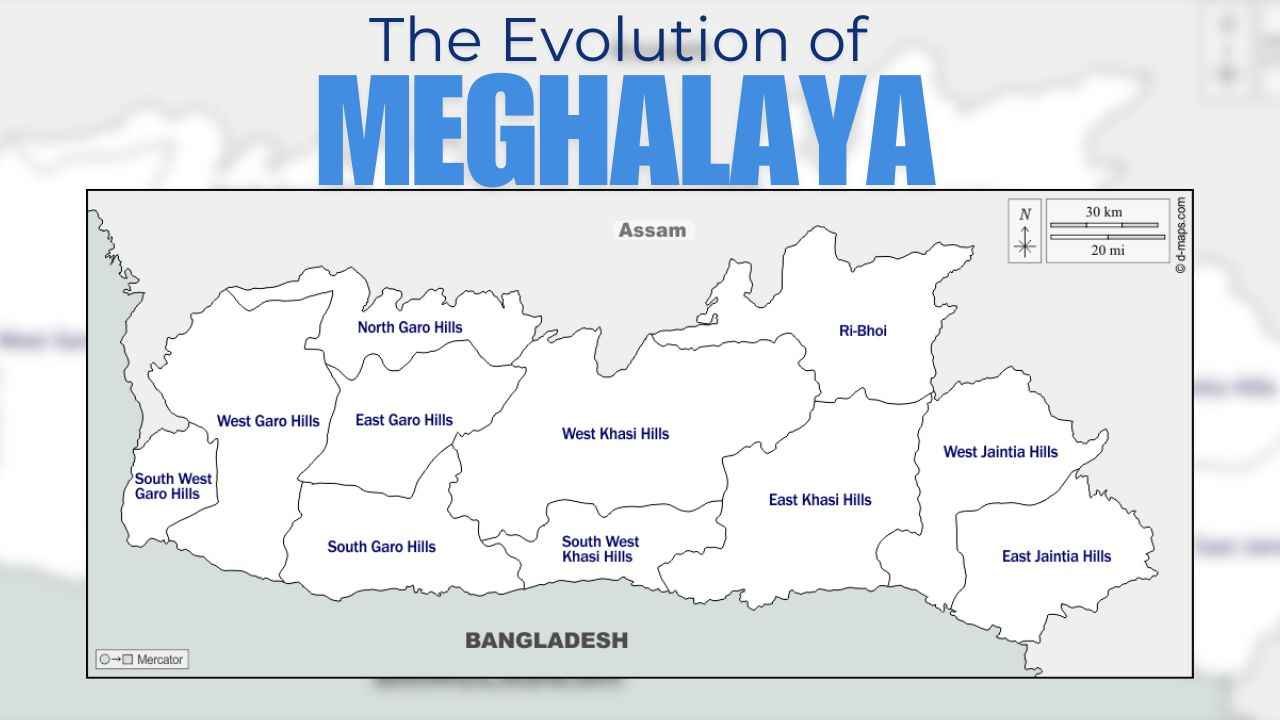The Evolution of Meghalaya

Meghalaya, the translated word is “abode of clouds,” the beauty lies in the name. Meghalaya is situated in North East region of India known, for its rich cultural heritage, natural beauty, and fascinating historical backdrop. Under the glory of all amazing things, Meghalaya has undergone a significant evolution over the years, shaped by its unique geography, cultural diversity, political history, and modern developments.
The Early Roots of Meghalaya (The Evolution of Meghalaya)
Meghalaya became a separate autonomous state on 21 January 1972. Before that Meghalaya used to be part of Assam and Shillong which is the current capital of Meghalaya used to be the capital of the entire Assam. Meghalaya separated from Assam with its three major districts Khasi Hills, Garo Hills, and Jaintia Hills, these three are the major communities of Meghalaya.
The Khasi people believed to be the earliest inhabitants of the region, with a history that stretches back thousands of years. The Jaintias, also known as the Syntengs, are a subgroup of the Khasi, and the Garo people, who inhabit the western part of the state, known for their matrilineal social system. The Garo’s traditional belief in the worship of nature and spirits, and the Khasi’s adherence to their matrilineal clan system, have played important roles in shaping the identity of Meghalaya.
Colonial Influence and Its Aftermath
The arrival of the British in the early 19th century brought significant changes to the region British colonial rule in Assam affected the tribal communities of Meghalaya, particularly in terms of the introduction of new political and administrative systems.
However, unlike other parts of India, the British kept the tribal areas of Meghalaya out of direct administration. They recognized as the traditional forms of governance, with the Khasi and Jaintia kings maintaining some degree of autonomy under British supervision. The British built a road connecting the Khasi hills with the rest of Assam, facilitating trade and communication.
Meghalaya's Growth Over Time
The demand for separate statehood got louder when a group All Party Hill Leaders’ Conference formed in July 1960, spearheaded the hill state movement under the leadership of stalwarts like Captain Williamson A. Sangma, who was also Meghalaya’s first chief minister, late Brington Buhai Lyngdoh, late Stanley D.D. Nichols Roy, the late Hoover Hynniewta, and many others. The Evolution of Meghalaya is very inspiring and motivating.
Under Williamson A. Sangma’s leadership, the Conference passed a resolution to send a request to the States Reorganization Commission for the creation of a separate “Eastern Hill State.” The request highlighted the following key points:
- The people of the hills and the plains differed from each other.
- The Assamese people imposing their language and culture on the hill tribes.
- The Assamese dominance in the legislature and the services (because of the majority)
At that time the Prime Minister of India was Indira Gandhi, she visited Shillong and promised that her government would fulfill the aspirations of the hill people.
Struggles and Development
In its early years, Meghalaya faced several challenges, including the need for infrastructure development, economic growth, and integration into the larger Indian polity. The state government focused on building key infrastructure such as roads, electricity, healthcare facilities, and educational institutions. However, the state’s remote location, difficult terrain, and political complexities made development a slow and difficult process.
During the 1980s and 1990s, the state faced significant political unrest, with ethnic tensions flaring up between the various tribal groups. The demand for greater autonomy and the protection of indigenous rights continued to dominate the political discourse. The evolution of Meghalaya compounded by issues like unemployment, migration, and the marginalization of the tribal economy, which often relied on subsistence farming.
Modern-day Meghalaya
In recent years, Meghalaya has experienced a shift toward modernization and economic growth. Tourism has emerged in places like Cherrapunji (known for its heavy rainfall), the Living Root bridges, the Mawlynnong village (which is often regarded as one of Asia’s cleanest), and the wildlife sanctuaries. The state’s tourism industry has been growing steadily, creating jobs and boosting the local economy. Local crafts, including handwoven textiles, traditional baskets, and pottery, have found markets both inside and outside India, and many entrepreneurs are working to promote the region’s unique handicrafts and culinary traditions.
Shillong’s development has been more rapid than that of other parts of the state. For example, education industries like institutions like North Eastern Hill University (NEHU) and St. Edmund’s College continue to be prestigious educational centers. Shillong has also emerged as a hub for music and arts, often called the “Rock Capital of India” due to its thriving music scene.
Also Check Out: The Wildlife of Meghalaya
Also Check Out: Top Musicians of Meghalaya
Pingback: The Wildlife of Meghalaya - A Unique Experience of the Wild
Pingback: Top Musicians of Meghalaya - Shillong Music Scene.